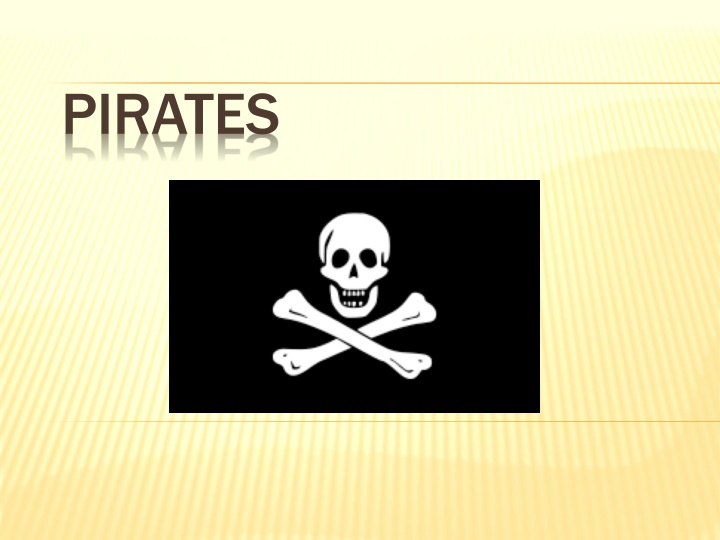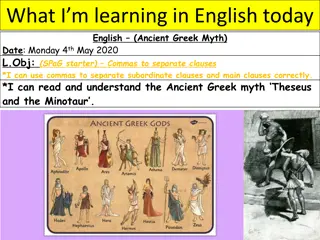History of Piracy: From Ancient Times to the Middle Ages
Piracy has a long history dating back to ancient times, with the Sea Peoples and Phoenicians engaging in acts of piracy. The Roman Empire also faced threats from pirates, including the infamous kidnapping of Julius Caesar. During the Middle Ages, Vikings were prominent pirates, raiding coasts and rivers across Europe. The lack of centralized power in Europe at the time favored piracy, leading to widespread attacks on shipping and coastal towns.
Download Presentation

Please find below an Image/Link to download the presentation.
The content on the website is provided AS IS for your information and personal use only. It may not be sold, licensed, or shared on other websites without obtaining consent from the author.If you encounter any issues during the download, it is possible that the publisher has removed the file from their server.
You are allowed to download the files provided on this website for personal or commercial use, subject to the condition that they are used lawfully. All files are the property of their respective owners.
The content on the website is provided AS IS for your information and personal use only. It may not be sold, licensed, or shared on other websites without obtaining consent from the author.
E N D
Presentation Transcript
PIRACY Piracy Piracy is a war-like act committed by non-state actors (private parties not affiliated with any government) against other parties at sea. The term applies especially to acts of robbery and/or criminal violence at sea. People who engage in these acts are called pirates pirates.
PRIVATEER A Privateer Privateer - a private person or ship authorized by a government by Letters of Marque to attack foreign shipping during wartime Letter of Marque Letter of Marque - a government license authorizing a person to attack and capture enemy vessels, and bring them before admiralty courts for condemnation and sale
EARLY HISTORY OF PIRACY Piracy existed as long as the oceans were used for commerce Earliest documentation of piracy are the exploits of the Sea People who threatened the Aegean and Mediterranean in the 13th century BCE Phoenicians sometimes resorted to piracy, and specialized in kidnapping boys and girls to be sold as slaves
EARLY HISTORY OF PIRACY (CONTD) During the 1st century BC, there were pirate states along the Anatolian coast, threatening the commerce of the Roman Empire in the eastern Mediterranean On one voyage across the Aegean Sea in 75 BC, Julius Caesar was kidnapped by Cilician pirates and held prisoner
EARLY HISTORY OF PIRACY (CONTD) Piracy continued during the entire rule of the Roman Empire As early as 258 AD, the Goth fleets ravaged towns on the coasts of the Black Sea In the Roman province of Britannia, Saint Patrick was captured and enslaved by Irish pirates. On the other side of the world, early Polynesian warriors attacked seaside and riverside villages
THE MIDDLE AGES AND THE VIKINGS In medieval Europe, the Vikings were the most widely known and far reaching pirates, mainly between 793 - 1066 They raided the coasts, rivers and inland cities of all Western Europe as far as Seville in 844 Vikings even attacked coasts of North Africa and Italy. They also plundered all the coasts of the Baltic Sea, ascending the rivers of Eastern Europe as far as the Black Sea and Persia. The lack of centralized powers all over Europe during the Middle Ages favoured pirates all over the continent
THE MEDITERRANEAN PIRATES In the Late Middle Ages, Moor pirates were common in the Mediterranean Sea Toward the end of the 9th century, Moor pirate havens were established along the coast of southern France and northern Italy In 846 Moor raiders sacked Rome and damaged the Vatican From 824 to 961 Arab pirates in the Emirate of Crete raided the entire Mediterranean
THE MEDITERRANEAN PIRATES (CONTD) Arab raids on the Adriatic coast in 887 888 caused continuing conflicts with the Italians The Venetians futilely continued to fight them throughout the 10th and 11th centuries In the 14th century, raids by Moor pirates forced the Venetian Duke of Crete to ask Venice to keep its fleet on constant guard
BRITISH ISLES AND PIRACY In 937, Irish pirates sided with the Scots, Vikings, Picts, and Welsh in their invasion of England, but they were driven back King Henry III took an especially severe view of the crime of piracy An Englishman named William Maurice was convicted of piracy in 1241 He was hanged, drawn and quartered
PIRACY IN THE INDIAN OCEAN Piracy was also prevalent in the Indian Ocean as early as the 7thcentury Constant wars between between various Indian factions demanded frequent resupply of fresh horses This trade was subject to frequent raids by pirates based in the coastal cities of Western India
AFRICA AND ASIAN PIRACY Piracy was rampant around Africa, particularly in Madagascar, where the pirate population numbered 1000 in the 17th 18thcentury The southern coast of the Persian Gulf became known as the Pirate Coast Meanwhile the Japanese were active in piracy from 1200 1600 But the most powerful pirate fleets of East Asia were those of the Chinese
THE CHINESE PIRATES Chinese pirate fleets grew increasingly powerful throughout the early 19th century The effects large-scale piracy had on the Chinese economy were immense Chinese pirates formed a coalition that, by 1804, consisted of over ten thousand men In the 1840s and 1850s, the United States Navy and Royal Navy forces campaigned together against Chinese pirates It wasn't until the 1860s and 1870s that fleets of pirate junks ceased to exist
THE BARBARY PIRATES Operated from the North African ("Barbary coast") ports of Algiers, Tunis, Tripoli and ports in Morocco They preyed on shipping in the western Mediterranean Sea from the time of the Crusades They also attacked ships on their way to Asia around Africa until the early 19th century Between 1 and 1.25 million Europeans were captured by Barbary pirates and sold as slaves in North Africa and Ottoman Empire between the 16th and 19th centuries
RANSOM FOR US SHIPS AND CREWS In July 1785, Algerians captured two American ships The Dey of Algiers held their crews of twenty-one people for a ransom of nearly $60,000 Thomas Jefferson opposed the payment of tribute - Lastly our determination to prefer war in all cases to tribute under any form, and to any people whatever" However, the United States continued to negotiate for cash settlements
HUGH PAYMENTS In 1795 alone the United States was forced to pay nearly a million dollars in cash, naval stores, and a frigate to ransom 115 sailors from the Dey of Algiers Annual gifts were settled by treaty on Algiers, Morocco, Tunis, and Tripoli When Jefferson became president in 1801 he refused Tripoli's demands for an immediate payment of $225,000 and an annual payment of $25,000.
THE BARBARY WAR The pasha of Tripoli then declared war on the United States Jefferson dispatched a squadron of naval vessels to the Mediterranean The American show of force quickly awed Tunis and Algiers into breaking their alliance with Tripoli Aggressive action of Commodore Edward Preble forced Morocco out of the fight
- - - - TO THE SHORES OF TRIPOLI American fleet under Commodore John Rogers and a land force threatened to capture Tripoli The threat to install the brother of Tripoli's pasha on the throne brought an end to the hostilities A second war with Algiers, in 1815, with naval victories by Commodores William Bainbridge and Stephen Decatur led to treaties ending all tribute payments by the United States European nations continued annual payments until the 1830s
THE GOLDEN AGE OF PIRACY THE GOLDEN AGE OF PIRACY
VIEW OF A TYPICAL PIRATE Peg Leg Arm Hook Cutlass Parrot Skull and Crossbones Eye Patch
YOUR TYPICAL PIRATE Blackbeard - Edward Teach
YOUR NOT SO TYPICAL PIRATE Anne Bonny & Mary Read
FAMOUS WOMEN PIRATES Anne Bonny Mary Read Mary Read
GRACE OMALLEY Grace O'Malley was a famous pirate, seafarer, trader and chieftain in Ireland in the 1500's. Born in 1530 in County Mayo, Ireland, the daughter of a sea captain As a young child, Grace always knew she wanted to be a sailor Extremely upset when her father refused to take her on a sailing trip, Grace cut off all her hair and dressed as a boy Eventually she was allowed to go to sea with her father and his fleet of ships.
GRACE OMALLEY She learned the ways of the sea and eventually had her own fleet of ships. In her later life, Grace took up piracy by taking on Turkish and Spanish pirate ships and even the English fleets. She grew her estate to include a fleet of ships as well as several islands and castles on the west coast of Ireland. In her later years, Grace developed her reputation as fearless in battle
ANNE BONNY Anne Bonny was a native of Cork; born to her father s servant Her father, a respected attorney eloped with the servant and Anne to America Anne married a young sailor without a shilling, enraging her father who threw them out of his home Anne and her husband sailed for the island of Providence, in the hope of gaining employment
ANNE BONNY Anne became estranged from her husband and eloped with the pirate, Captain Jack Rackam (Calico Jack), and went to sea in men's clothes When the king's offered a pardon to all pirates, Rackam surrendered, and went into privateering He soon returned to his piratical exploits, joined by Anne Bonny and Mary Read They were captured by the British Anne Bonny, Mary Read and a seaman were the last three who remained fighting when the vessel was taken
ANNE BONNY By a special favor, Rackam was permitted to visit her the day before he was executed Instead of consoling him, she only observed that if he had fought like a man he needed not have been hanged like a dog Being with child, she remained in prison until her recovery, was reprieved from time to time, and was not executed
MARY READ Mary Read was a native of England Her mother married a sailor who, soon after their marriage, went to sea, left her pregnant, and never returned After the birth of Mary, her mother convinced her husband s mother that Mary was a boy The grandmother provided Mary s mother a crown per week for his support
MARY READ Mary s mother continued to rear her daughter as a boy After the grandmother died, the allowance stopped Mary s strength and manly disposition increased with her years She eventually signed on board a man-of-war She joined a regiment of foot as a cadet and later enlisted into a regiment of horse
MARY READ She again enlisted into a regiment of foot She went on board a vessel bound for the West Indies During the voyage, the vessel was captured by English pirates Mary joined the pirates and continued with them for some time She then joined a ship to serve onboard as a privateer
MARY READ Scarcely had the ships sailed, when the crew mutinied to return to pirating Among the crew were Mary Read and Anne Bonny When the vessel was taken, these two heroines, along with another of the pirates, were the last three upon deck Mary Read was captured and tried, but because she was pregnant her execution was delayed While she would probably been spared, in the mean time she fell sick and died
OTHER FAMOUS WOMEN PIRATES Lady Mary Killigrew vicious pirate from Cornwall Charlotte de Berry another woman who went to sea dressed as a man Rachel Wall the first American woman pirate Loi Chai-san- Queen of the Macao pirates during the 1920s
A FINAL NOTE ON CROSS-DRESSING Mary Read maintained her role as a man for many years and no one had discovered her gender Not until she told Anne Bonny Anne, supposing Mary to be a handsome fellow, became greatly enamored of her Anne disclosed to Mary that she (Anne) was a woman and was interested in Mary Now Mary was forced to reveal her secret to Anne
THE SPANISH MAIN The term the 'Spanish Main' is often associated with famous pirates The Spanish Main referred to the coastal region of the Americas surrounding the Caribbean Sea and South America The Spanish established colonies on the land in the New World and also claimed specific sea routes
THE SPANISH MAIN The territories around the Spanish Main opened up paths to the new wealth which was found in the New World Ships were loaded with their treasure to send back to Spain These Spanish treasures fleets were attacked by many of the famous pirates The Pirates of the Spanish Main used many of the Caribbean Islands as their bases. The traffic in treasure made the Spanish Main a haunt of famous pirates and privateers
THE GOLDEN AGE OF PIRACY The Golden Age of Piracy lasted just over 100 years form the 1500's to the mid 1600 s The Spanish were continuously harassed in the Caribbean by pirates and buccaneers who attacked the Spanish galleons which were carrying riches back to Spain There were safe havens for pirates, or pirate enclaves, all over the world but Port Royal and Jamaica were famous examples of places where pirates could gather without fear of attack or arrest
BENEFITS OF BEING A PIRATE Many seamen who had served in merchant or naval ships, turned to the lucrative, but dangerous occupation of being a pirate Pirate crews were treated much better than the navy crews who were subjected to harsh, rules, treatment and punishment and low wages - many were press-ganged into service The pirate ships were governed by their own laws, called Articles, which were agreed between the pirate crew and the captain
THE PIRATE CODE OF CONDUCT Pirate Code of Conduct 1 Pirate Code of Conduct 1 - - Equal Voting Rights Equal Voting Rights Pirate Code of Conduct 2 Pirate Code of Conduct 2 - - Fair share of the loot and pirates punishments for Fair share of the loot and pirates punishments for those who cheated those who cheated Pirate Code of Conduct 3 Pirate Code of Conduct 3 - - Gambling was banned Gambling was banned Pirate Code of Conduct 4 Pirate Code of Conduct 4 - - No lights at night disturbed disturbed No lights at night - - a pirates sleep should not be a pirates sleep should not be Pirate Code of Conduct 5 Pirate Code of Conduct 5 - - Each pirate was responsible for the upkeep of their Each pirate was responsible for the upkeep of their weapons weapons Pirate Code of Conduct 6 Pirate Code of Conduct 6 - - No Boys or women allowed on board No Boys or women allowed on board Pirate Code of Conduct 7 Pirate Code of Conduct 7 - - Penalty for Desertion Penalty for Desertion Pirate Code of Conduct 8 Pirate Code of Conduct 8 - - No fighting between pirates on board the ship No fighting between pirates on board the ship Pirate Code of Conduct 9 Pirate Code of Conduct 9 - - A Pension according to the severity of wounds A Pension according to the severity of wounds Pirate Code of Conduct 10 Pirate Code of Conduct 10 - - Shares of the loot or booty Shares of the loot or booty Pirate Code of Conduct 11 Pirate Code of Conduct 11 - - Musicians available to play when required! Musicians available to play when required!
THE PIRATE SONG The most famous words are from the first four lines of this pirate song are : Fifteen men on a dead man's chest Yo ho ho and a bottle of rum Drink and the devil had done for the rest Yo ho ho and a bottle of rum.
THE PIRATE SONG What does the song mean? - Dead Man's Chest is a tiny island that forms part of the British Virgin Islands in the Caribbean Sea. Pirate legends of the Caribbean claim that the notorious pirate, Edward Teach ( Blackbeard ), marooned 15 of his pirate crew on 'Dead Man's Chest' as a punishment for their mutiny and desertion
THE PIRATES OF THE GOLDEN AGE The celebrated English Explorers Sir John Hawkins and Sir Francis Drake were classed as famous pirates The pirates who operated in the Caribbean in later years included Blackbeard, Calico Jack (Jack Rackham), Anne Bonny and Henry Morgan Other famous pirates operating in the Caribbean included Black Bart, Henry Every, and Captain Kidd
BLACKBEARD EDWARD TEACH (1680 1718) The best known non-fictional pirate even though he was not the most successful He is remembered mainly because of his image that he himself helped to create He was said to be a somewhat amiable man and generous to those that cooperated with him Teach was also apparently a ladies man. It is said that he had around 14 wives.
BLACKBEARD EDWARD TEACH Teach captured the Concorde, a large French trader carrying a cargo of slaves He re-christened it the Queen Anne s Revenge, and installed 40 guns He really made his reputation when he engaged and defeated HMS Scarbourough It was at this time that he created his well-known Blackbeard persona He knew that if he looked frightening then ships might surrender to him sooner
BLACKBEARD EDWARD TEACH He let his hair grow and started a beard that would almost cover his face He twisted his long hair and beard in pigtails and he was known to tie colored ribbons on the ends During battle he put lit slow burning hemp cords under his hat near his ears that would smoke and envelop him in a cloud To add to his menacing appearance he also wore several pistols (as much as six) along with his knives and cutlass at his waist
BLACKBEARD EDWARD TEACH After capturing many prizes and valuable cargos, Blackbeard decided to take advantage of the King s pardon and retire from pirating However, he could not stay away and eventually was defeated by two sloops manned by Royal Navy crews It was reported that Blackbeard fell with at least five gun shot wounds and at least 20 sword wounds His severed head was hung from sloop's bowsprit as a trophy and to prove that the legendary Blackbeard the pirate was indeed dead
CAPTAIN WILLIAM KIDD (1645 1701) Born in Dundee, Scotland One of the most well known Pirates of all times He was an English Privateer who found such success in the West Indies The King s officers asked Kidd to captain a new powerful ship - the Adventure Galley, equipped with 34 cannons and a crew of 80 Kidd s mission was to capture all French ships, and the pirates of Madagascar
CAPTAIN WILLIAM KIDD A good portion of his new crew left Kidd s ship in order to join the pirates The remaining portion of pirates on Kidd s crew, threatened him with mutiny, unless Kidd would attack any and all ships Kidd refused After Kidd killed the mutiny leader, the crew did not pursue the revolt further However, Kidd was a changed man and he now became a pirate
CAPTAIN WILLIAM KIDD Kidd decided to plunder the Quedagh Merchant, a huge treasure ship Captain Kidd was in the possession of one of the greatest pirate treasures ever With this final accomplishment under his belt, he ordered his crew to set sail for New York He thought he could fool the New Yorkers into believing that all his plunder had been taken only from French and pirate vessels Unfortunately for him, he was very mistaken - a great deal of the booty belonged to the powerful British East India Company
CAPTAIN WILLIAM KIDD Kidd was clapped into chains and shipped to England were he was sentenced to death Kidd experienced a terrible death - the hangman s rope broke twice, the third time it held Once Kidd was dead: his body was dipped in tar and hung by chains along the Thames River There are a number of accounts which state that Kidd was falsely accused and unfairly tried and executed


![READ⚡[PDF]✔ European Mail Armour: Ringed Battle Shirts from the Iron Age, Roman](/thumb/20552/read-pdf-european-mail-armour-ringed-battle-shirts-from-the-iron-age-roman.jpg)




















